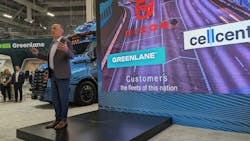DTNA sets up ‘second life’ for commercial EV batteries
LAS VEGAS—Daimler Truck North America’s attention to sustainability is turning to maximizing electric truck batteries’ usefulness through a “second life.”
The strategy emphasizes repairing, remanufacturing, repurposing, and recycling lithium-ion battery materials used in all DTNA EVs. The OEM detailed its plans during a presentation here at the Advanced Clean Transportation Expo.
David Carson, DTNA SVP of sales and marketing, noted that electric truck batteries are the most expensive part of commercial EVs. “Batteries are something that we look at for the life cycle of that vehicle to ensure that the customer is able to achieve that total cost of ownership parity,” he said. “But we’re not just focused on the life cycle of the battery within the utilization of the truck. We’re focused on recycling, repurposing, and remanufacturing batteries once they do reach the end-of-life stage.”
Using a circular economy approach, DTNA’s goal is to maximize the life span of a battery while reducing material waste. That approach, company leaders explained, would extend the usefulness of rare-earth materials and products. DTNA said its technology can detect when lithium-ion batteries no longer meet vehicle-use standards and figure out the optimal process to maximize materials for a second life—with repairs taking precedence if possible.
DTNA, which makes Freightliner and Western Star trucks in the U.S., has global corporate goals to achieve carbon neutrality for all new products and services from direct suppliers in the U.S., Europe, and Japan by 2039. Parent company Daimler Truck’s Rizon brand produces medium-duty EVs for North America in Japan.
In 2020, the Portland Truck Manufacturing Plant, where the Freightliner eCascadia and eM2 are built, committed to CO₂-neutral production by reducing energy consumption and offsetting on-site emissions. DTNA plans to achieve CO₂-neutral production at all its remaining truck manufacturing plants by 2025.
See also: Geotab and DTNA partner to simplify fleet management
How Daimler Truck plans to give EV batteries a ‘second life’
While batteries receive significant attention due to their use of rare-earth metals like cobalt and nickel, DTNA’s approach extends to all components of the EV product.
“As part of our commitment to maximizing material life cycles, we meticulously assess environmental and ethical implications from sourcing to post-production,” said Rakesh Aneja, VP and chief of Zero-Emission Transformation Group at DTNA. “Our primary goal is to repair our lithium-ion battery materials and reduce the consumption of new resources.”
Here’s how Daimler Truck North America details its second-life battery strategy through remanufacturing, repurposing, and recycling:
Remanufacture
When a battery or electric vehicle component is beyond simple repair, it undergoes remanufacturing at existing Detroit Diesel Remanufacturing locations across the U.S., such as the recently expanded Hibbing facility, with intended reuse in vehicles. This process involves partial disassembly, module replacement, and rigorous testing for optimized reliability. All remanufactured products are updated with the latest technology and must meet or exceed DTNA’s new product standards to be reintroduced to the market.
According to the company, remanufactured products are a cost-effective solution that improves the total cost of ownership, benefiting both DTNA’s customers and the environment. Today, Detroit batteries and eAxles are the primary DTNA EV components for remanufacturing, with potential for future expansion.
Repurpose
DTNA partnered with Nuvation Energy to pilot a battery energy storage system, known as BESS, designed to assist in charging, peak shaving, backup storage, and microgrid scenarios. This solution enables DTNA to repurpose batteries that cannot be reused in a vehicle.
“Battery energy storage systems play a pivotal role in the electric vehicle ecosystem, given the escalating demand for charging infrastructure and limitations of the current power grid,” Aneja said. “As the number of EVs on the road increases, the existing grid capacity may struggle to meet charging demands. Energy storage systems alleviate this issue by facilitating off-peak charging, utilizing stored power when needed, and reducing reliance on the grid.”
Recycle
DTNA has created a process in partnership with Li-Cycle, a leading lithium-ion battery resource recovery company, to responsibly recycle critical battery-grade materials for batteries that reach the end of their life cycle. Li-Cyle uses an environmentally friendly and safe method that recycles batteries within a liquid-based solution, achieving up to a 95% recovery rate for returning critical materials back to the battery supply chain while producing minimal water discharge.
“This circular approach extends beyond just batteries,” concluded Aneja. “We are actively working to apply this concept to other facets of our product development, aiming to increase our utilization of reusable or recyclable materials. Our goal is to continue contributing positively to the preservation of our planet for future generations.”
About the Author
Josh Fisher
Editor-in-Chief
Editor-in-Chief Josh Fisher has been with FleetOwner since 2017. He covers everything from modern fleet management to operational efficiency, artificial intelligence, autonomous trucking, alternative fuels and powertrains, regulations, and emerging transportation technology. Based in Maryland, he writes the Lane Shift Ahead column about the changing North American transportation landscape.

